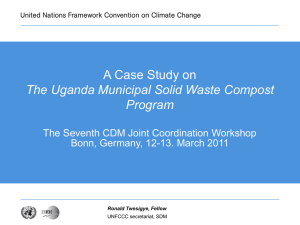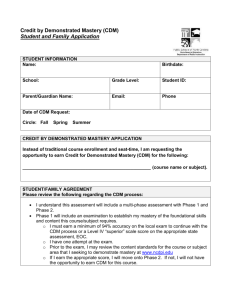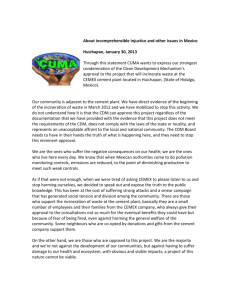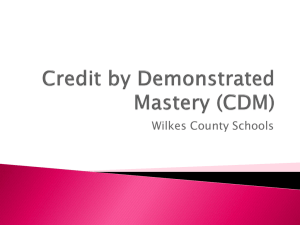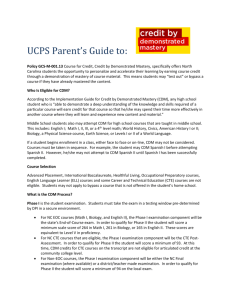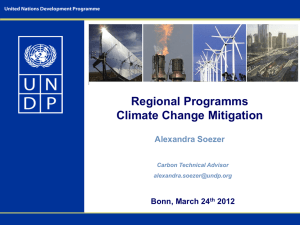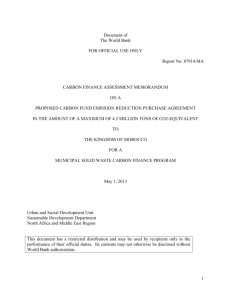project information document (pid) - Documents & Reports
advertisement
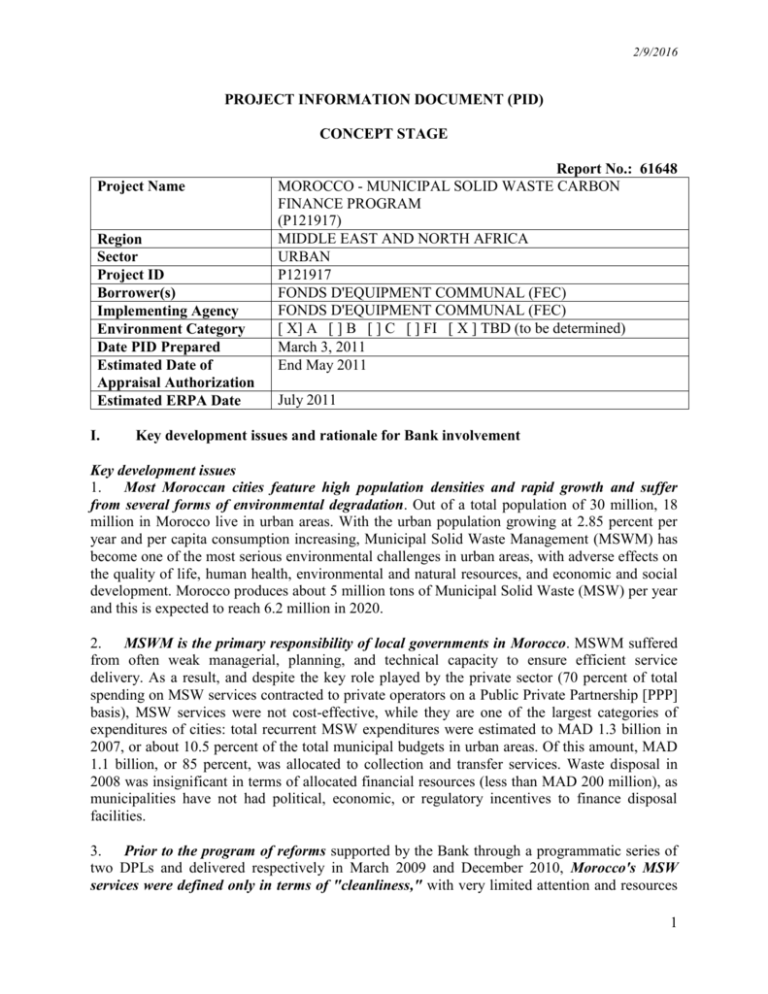
2/9/2016 PROJECT INFORMATION DOCUMENT (PID) CONCEPT STAGE Project Name Region Sector Project ID Borrower(s) Implementing Agency Environment Category Date PID Prepared Estimated Date of Appraisal Authorization Estimated ERPA Date I. Report No.: 61648 MOROCCO - MUNICIPAL SOLID WASTE CARBON FINANCE PROGRAM (P121917) MIDDLE EAST AND NORTH AFRICA URBAN P121917 FONDS D'EQUIPMENT COMMUNAL (FEC) FONDS D'EQUIPMENT COMMUNAL (FEC) [ X] A [ ] B [ ] C [ ] FI [ X ] TBD (to be determined) March 3, 2011 End May 2011 July 2011 Key development issues and rationale for Bank involvement Key development issues 1. Most Moroccan cities feature high population densities and rapid growth and suffer from several forms of environmental degradation. Out of a total population of 30 million, 18 million in Morocco live in urban areas. With the urban population growing at 2.85 percent per year and per capita consumption increasing, Municipal Solid Waste Management (MSWM) has become one of the most serious environmental challenges in urban areas, with adverse effects on the quality of life, human health, environmental and natural resources, and economic and social development. Morocco produces about 5 million tons of Municipal Solid Waste (MSW) per year and this is expected to reach 6.2 million in 2020. 2. MSWM is the primary responsibility of local governments in Morocco. MSWM suffered from often weak managerial, planning, and technical capacity to ensure efficient service delivery. As a result, and despite the key role played by the private sector (70 percent of total spending on MSW services contracted to private operators on a Public Private Partnership [PPP] basis), MSW services were not cost-effective, while they are one of the largest categories of expenditures of cities: total recurrent MSW expenditures were estimated to MAD 1.3 billion in 2007, or about 10.5 percent of the total municipal budgets in urban areas. Of this amount, MAD 1.1 billion, or 85 percent, was allocated to collection and transfer services. Waste disposal in 2008 was insignificant in terms of allocated financial resources (less than MAD 200 million), as municipalities have not had political, economic, or regulatory incentives to finance disposal facilities. 3. Prior to the program of reforms supported by the Bank through a programmatic series of two DPLs and delivered respectively in March 2009 and December 2010, Morocco's MSW services were defined only in terms of "cleanliness," with very limited attention and resources 1 2/9/2016 allocated to waste disposal or treatment. The resulting impacts on the quality of life, public health, environmental and natural resources, and vital economic activities such as tourism, were huge. Major issues and challenges in the sector prior to formulation of reform program included: (i) poor sector policy focuses mainly on "cleanliness" with very limited attention to waste disposal or treatment; (ii) weak legal and institutional framework, which constrains effective strategic planning and governance; (iii) ad-hoc fiscal transfers to municipalities and uncertain financial sustainability; (iv) poor cost effectiveness of PPP mainly due to limited competition, lack of transparency, and poor accountability; and (v) huge impacts on the quality of life, public health, local and global environment, and social and economic development. 4. Since 2009, with the support of the Bank, the overall reform focuses on three main areas: (i) improve governance of the sector through additional legal, regulatory, and institutional measures designed to establish a clear framework for the sector, and eliminate overlap and/or gaps in the policy-making, regulatory, and operational structure; (ii) improve the sustainability of the sector through the introduction of financial mechanisms and incentives for municipalities to improve MSWM systems; and (iii) mainstream social and environmental considerations into the planning, implementation, and operations of solid waste services and investments. 5. The proposed program will provide equal opportunities to municipalities in gaining access to the carbon market. The program coordinated and managed by FEC will provide a framework under which any interested municipality, or group of municipalities, will be able to develop a CDM project activity in the solid waste management sector, as long as it meets the eligibility criteria established by the CDM. Revenue potential for carbon emission reductions from improved MSW practices is being considered in all future waste management planning. Rationale for Bank involvement. 6. Combat climate change trough the promotion of carbon finance has emerged as a key concern for the World Bank and its clients, especially after the 2005 G8 Summit in Gleneagles. The Bank has been a leader in the field and incorporated these considerations into its development operations. Through its extensive experience gained as Trustee of several carbon funds, the Bank is well positioned to integrate and maximize the potential of carbon finance in the solid waste sector. 7. The World Bank is uniquely positioned to support this program due of its Extensive experience in Carbon Finance. The Bank has contributed significantly to the development of the carbon market and currently manages 12 carbon funds and facilities, acting as a trustee on behalf of public and private sector participants. The CPF is one of the carbon funds managed by the Bank and aims at promoting a programmatic approach. The Bank’s Carbon Finance Unit uses funds contributed by governments and companies in OECD/Annex 1 countries to purchase GHG ERs in developing countries and economies in transition under the CDM and Joint Implementation (JI) mechanism in the framework of the Kyoto Protocol, or under alternative emerging schemes. At the end of 2009, contributions by participants in the Bank's carbon funds and facilities reached USD2.5 billion. 2 2/9/2016 8. The program fits into the Carbon Finance Strategy of the Bank. Specifically, the program is in agreement with the following strategic objectives of the Bank’s Carbon Finance Unit (ENVCF): High-quality ERs to show how project-based GHG emission reduction transactions can promote and contribute to sustainable development and lower the cost of compliance with the Kyoto Protocol. Knowledge and dissemination to enable the Parties to the UNFCCC, the private sector, and other interested parties to “learn by doing” in the development of policies, rules and business processes to achieve ERs under the CDM. Consistent with both the requirements set forth by the host country sustainable development strategy and the Bank high standards in terms of public consultation and environmental assessment. II. Proposed objective 9. The main objective of the proposed project is to help Moroccan Municipalities develop carbon assets in solid waste sector, and access the carbon market. More specifically, the proposed CDM Program of Activities (POA will allow the purchase of 2,000,000 Certified Emissions Reductions (CERs), labeled in tons of CO2-equivalent (tCO2e), through an ERPA under the Bank-managed Carbon Partnership Facility. 10. These ERs will be generated through (i) the avoidance of methane (CH4) emissions from MSW landfills in Morocco, by promoting LFG capture and flaring, and/or electricity generation projects, and (ii) the reduction of carbon dioxide (CO2) emissions through the displacement of fossil fuel-based electrical power generation. 11. The CDM POA will generate additional revenues through the sale of CERs under the CDM. Additional resources from carbon finance could help cover part of the cost of municipal solid waste disposal. III. Preliminary description 12. The proposed program of activities will provide a framework under which any interested municipality, or group of municipalities, will be able to develop a CDM project activity in the SWM sector, as long as it meets the eligibility criteria established by the CDM. By pooling similar project activities under one commonly-managed CDM program of activities, municipalities will be able to gain access to the carbon market at a relatively low cost, taking full advantage of economies of scale and keeping transaction costs down. 13. The LFG CDM projects will be implemented by the municipalities on a voluntary basis. Municipalities would either construct and operate the project themselves or contract it out to the private sector. FEC will be the coordinating entity, provide assistance for the preparation of individual CDM projects, and sell the CER to the CPF. 3 2/9/2016 14. About 10 landfills in Morocco are expected to join the program. It is estimated that up to 10 LFG projects, including those of main Moroccan municipalities included in the first phase of the PNDM, will join the CDM program. This could represent a total volume of waste of 2.9 million tons per year and average emission reductions of 735,000 tCO2e per year, amounting to 7.35 million tCO2e over ten years, of which the sale of 2 million tCO2e would be secured through the ERPA with the CPF. These figures take into consideration only gas capture and flaring. 15. The CDM Program will initially focus on municipalities and sites included in the first phase (2008-2012) of the National Municipal Solid Waste Management Program (PNDM). The first landfill to be included in the POA is located in Oum Azza, approximately 15 km from Rabat. This landfill receives on average 1,400 tons of waste daily with an annual growth rate of 3 percent. The gas capture commissioning is expected in November 2011 and should generate 0.9 MtCO2eq over the 2012-2017 period. Five other potential landfills are to generate 0.8 MtCO2eq over the period 2012-2018 and should be commissioned in 2012. Three additional projects are expected to be commissioned in 2013 and generate approximately 3.0 MtCO2eq over the period 2013-2019. This first operation will also be reviewed from the point of view of the environmental and social sustainability as part of the Safeguards Diagnostic Review. IV. Safeguard Policies that might apply Safeguard Policies Triggered by the Project Environmental Assessment (OP/BP 4.01) Natural Habitats (OP/BP 4.04) Pest Management (OP 4.09) Physical Cultural Resources (OP/BP 4.11) Involuntary Resettlement (OP/BP 4.12) Indigenous Peoples (OP/BP 4.10) Forests (OP/BP 4.36) Safety of Dams (OP/BP 4.37) Projects in Disputed Areas (OP/BP 7.60)* Projects on International Waterways (OP/BP 7.50) Piloting the Use of Borrower Systems to Address Environmental and Social Issues in Bank-Supported Projects (OP/BP 4.00) V. Yes No X X X X TBD X X X X X X X Tentative financing Source: IBRD Amount (US$m.): IDA Amount (US$m.): GEF Amount (US$m.): CPF Amount (US$m.): ($m.) 0 0 0 20 * By supporting the proposed project, the Bank does not intend to prejudice the final determination of the parties' claims on the disputed areas 4 2/9/2016 Other financing amounts by source: Borrower/Recipient (US$m.): Total VI. Contact point Contact: Title: Tel: Fax: Email: Location: VII. 0 0 20 Jaafar Sadok Friaa Lead Urban Specialist (202) 473-7124 (202) 477-6391 jsfriaa@worldbank.org Washington, DC For more information contact The InfoShop The World Bank 1818 H Street, NW Washington, D.C. 20433 Telephone: (202) 458-5454 Fax: (202) 522-1500 Web: http://www.worldbank.org/infoshop 5

